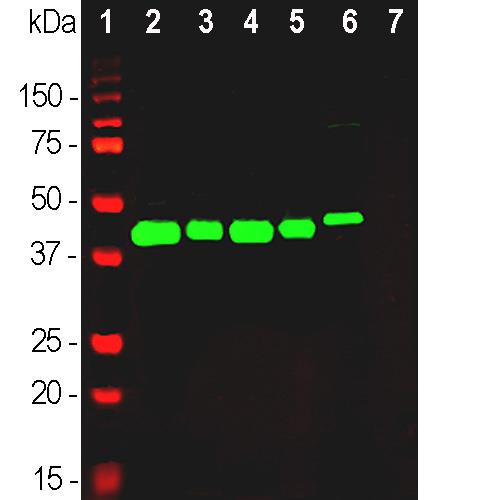GAP43 is a nervous system specific, growth-associated protein enriched in growth cones and areas of high plasticity. Phosphorylation of GAP43 at Ser41 by PKC is regulated by intracellular Ca2+ and affects the ability of GAP43 to bind calmodulin. GAP43 is integral to growth cone formation, neurite outgrowth, and the development of a functional cerebral cortex. Aberrant GAP43 expression can be seen in patients diagnosed with schizophrenia and Alzheimer's disease.
GAP43 (growth associated protein 43, also called B-50, PP46, calmodulin-binding protein P-57, neuromodulin, neuron growth-associated protein 43, protein F1) is a major component of motile "growth cones" that form the tips of elongating axons as well as the synaptic plasma membranes. GAP43 is associated with nerve growth process and plays a key role in axonal as well as dendritic filopodia induction. It has been detected in a complex containing FGFR4, NCAM1, CDH2, PLCG1, FRS2, SRC, SHC1, GAP43 and CTTN, and binds calmodulin with superior affinity in the absence of Ca2+ than in its presence. Intracellular Ca2+ regulates PKC mediated phosphorylation of GAP43 and affects GAP43's ability to bind calmodulin. GAP43 is integral to growth cone formation, neurite outgrowth, and the development of a functional cerebral cortex. Aberrant expression of GAP43 has been seen in patients diagnosed with schizophrenia and Alzheimer's disease. Three GAPs (Growth associated proteins) were discovered, and the number 43 comes from the apparent SDS-PAGE molecular weight of the one named GAP43. The HGNC name for this protein is, not surprisingly, GAP43. Later work showed that GAP43 does not run on SDS-PAGE in a fashion which accurately reflects its molecular weight, and that GAP43 proteins from different species may run at different apparent molecular weights. Partly due to these features GAP43 was independently discovered by several different groups and therefore has several alternate names, such as protein F1, pp46, neuromodulin, neural phosphoprotein B-50 and calmodulin-binding protein P-57. In each case the number reflects the apparent SDS-PAGE molecular weight, and underlines the unusual SDS-PAGE mobility properties of this molecule. Mammalian GAP43 proteins contains only 226-243 amino acids, and so the real molecular weight is 23.61-25.14 kDa (to perform such calculations yourself see this link). GAP43 is one of many highly negatively charged extended molecules which lack well defined tertiary structure and contain few hydrophobic residues and which run anomalously on SDS-PAGE. Other examples are CAP23, MARCKS, microtubule associated proteins MAP2, tau and the Neurofilament subunits. GAP43 has been extensively studied and is known to be a major protein kinase C substrate and to bind calmodulin avidly. GAP43 is anchored to the plasma membrane by palmitoylation modifications.

